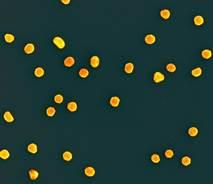Physico-Chemical Measurement Protocols

The development of a physico-chemical measurement protocol is challenging for a number of reasons. Measurements must be conducted in relevant media, including complex environmental and biological matrices; however, the media capabilities of many commercial instruments are limited to air, vacuum, and/or simple aqueous solutions. Different measurement techniques will yield different values for a given property because each technique measures different aspects of that property. This is well-illustrated by NIST reference material 8012, Gold Nanoparticles, Nominal 30 nm Diameter, for which particle diameters determined by six different techniques ranged from (24.9 ± 1.1) nm to (28.6±0.9) nm. Transformations such as agglomeration and dissolution may occur during a measurement, complicating interpretation of the results.

- NIST SP 1200-6: Measuring the Size of Nanoparticles in Aqueous Media Using Batch-Mode Dynamic Light Scattering, Version 1.2
DOI: http://dx.doi.org/10.6028/NIST.SP.1200-6 - NIST SP 1200-10: Challenges, Strategies and Opportunities for Measuring Carbon Nanotubes within a Polymer Composite by X-ray Photoelectron Spectroscopy
DOI: http://dx.doi.org/10.6028/NIST.SP.1200-10 - NIST SP 1200-13: Measurement of silver nanoparticle dissolution in complex biological and environmental matrices using UV/visible absorbance measurements
DOI: http://dx.doi.org/10.6028/NIST.SP.1200-13 - NIST SP 1200-15: Protocols for Accelerating Laboratory Weathering and Measurements of Degradation of Polymer-Multiwalled Carbon Nanotube Composites
DOI: http://dx.doi.org/10.6028/NIST.SP.1200-15 - NIST SP1200-17: Strategies for Scanning Electron Microscopy Sample Preparation and Characterization of Multiwall Carbon Nanotube Polymer Composites
DOI: http://dx.doi.org/10.6028/NIST.SP.1200-17 - NIST SP 1200-21: Characterization of Nanoparticle Suspensions Using Single Particle Inductively Coupled Plasma Mass Spectrometry
DOI: http://dx.doi.org/10.6028/NIST.SP.1200-21 - NIST SP 1200-22: Challenges and Approaches for Particle Size Analysis on Micrographs of Nanoparticles Loaded onto Textile Surfaces
DOI: https://doi.org/10.6028/NIST.SP.1200-22 -
NIST SP 1200-25: Protocol for Collecting and Quantifying Release from Weathered Epoxy-Nanosilica Coatings: Using a Simulated Rain Method and Inductively Coupled Plasma-Optical Emission Spectrometry
DOI: https://doi.org/10.6028/NIST.SP.1200-25 -
NIST SP 1200-26: Assessing the Chemical and Colloidal Stability of Functionalized Gold Nanoparticles
DOI: https://doi.org/10.6028/NIST.SP.1200-26
Numerous protocols were developed in conjunction with the Nanotechnology Characterization Laboratory, National Cancer Institute, National Institutes of Health. Some of these protocols will form the basis for future NIST Special Publications to be posted.

